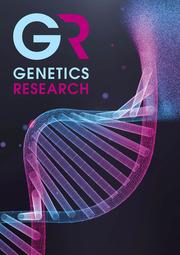Crossref Citations
This article has been cited by the following publications. This list is generated based on data provided by
Crossref.
Forejt, J.
Gregorov�, S.
and
Goetz, P.
1981.
XY pair associates with the synaptonemal complex of autosomal male-sterile translocations in pachytene spermatocytes of the mouse (Mus musculus).
Chromosoma,
Vol. 82,
Issue. 1,
p.
41.
Condamine, Hubert
Guénet, Jean-Louis
and
Jacob, François
1983.
Recombination between two mouset-haplotypes (tw12tfandtLub-1): segregation of lethal factors relative to centromere and tufted (tf) locus.
Genetical Research,
Vol. 42,
Issue. 3,
p.
335.
Baranov, V. S.
1983.
Chromosomal control of early embryonic development in mice: II. Experiments on embryos with structural aberrations of autosomes 7, 9, 14 and 17.
Genetical Research,
Vol. 41,
Issue. 3,
p.
227.
Plat, Marika
and
Condamine, Hubert
1984.
Recombination between two mouse t haplotypes (t w12 tf) and t Lub-1) : Mapping. of the H-2 complex relative to centromere and tufted (tf) locus.
Immunogenetics,
Vol. 20,
Issue. 3,
p.
277.
Artzt, Karen
1984.
Gene mapping within the T/t complex of the mouse. III: t-lethal genes are arranged in three clusters on chromosome 17.
Cell,
Vol. 39,
Issue. 3,
p.
565.
Forejt, J.
1984.
Chromosomes Today.
p.
117.
Röhme, Dan
Fox, Howard
Herrmann, Bernhard
Frischauf, Anna-Maria
Edström, Jan-Erik
Mains, Paul
Silver, Lee M.
and
Lehrach, Hans
1984.
Molecular clones of the mouse t complex derived from microdissected metaphase chromosomes.
Cell,
Vol. 36,
Issue. 3,
p.
783.
Lader, Eric
Clark, Brian T.
Jhanwar, S. C.
Chaganti, R. S. K.
and
Bennett, Dorothea
1985.
Definitive chromosomal location of the H-2 complex by in situ hybridization to pachytene chromosomes.
Immunogenetics,
Vol. 22,
Issue. 1,
p.
49.
de Boer, Peter
1986.
Chemical Mutagens.
p.
427.
Justice, Monica J.
and
Bode, Vernon C.
1986.
Induction of new mutations in a mouset-haplotype using ethylnitrosourea mutagenesis.
Genetical Research,
Vol. 47,
Issue. 3,
p.
187.
Uehara, H.
Abe, K.
Park, C.-H.
Artzt, K.
and
Bennett, D.
1987.
Human Genetics.
p.
272.
Handel, Mary Ann
1987.
Spermatogenesis Genetic Aspects.
Vol. 15,
Issue. ,
p.
1.
Artzt, Karen
Calo, Catherine
Pinheiro, Elizabeth Neuner
Dimeo‐Talento, Althea
and
Tyson, Frederick L.
1987.
Ovarian teratocarcinomas in LT/Sv mice carrying t‐mutations.
Developmental Genetics,
Vol. 8,
Issue. 1,
p.
1.
Mosinger, Bedřich
Králová, Jarmila
and
Forejt, Jiří
1988.
A cloned H-2 class I gene from a t
w32-derived recombinant t haplotype identified as functional tH-2KtH-2KtH-2K
q
gene.
Immunogenetics,
Vol. 28,
Issue. 4,
p.
283.
Forejt, Jiří
Gregorová, Soňa
and
Jansa, Petr
1988.
Three newt-haplotypes ofMus musculusreveal structural similarities tot-haplotypes ofMus domesticus.
Genetical Research,
Vol. 51,
Issue. 2,
p.
111.
Vincek, Vladimir
Kawaguchi, Hiroshi
Mizuno, Kazuya
Zaleska-Rutczynska, Zofia
Kasahara, Masanori
Forejt, Jiří
Figueroa, Felipe
and
Klein, Jan
1989.
Linkage map of mouse chromosome 17: Localization of 27 new DNA markers.
Genomics,
Vol. 5,
Issue. 4,
p.
773.
Agulnik, Alexander I.
Agulnik, Sergei I.
and
Ruvinsky, Anatoly O.
1991.
Meiotic drive of t haplotypes: chromosome segregation in mice with tertiary trisomy.
Genetical Research,
Vol. 57,
Issue. 1,
p.
51.
Klein, Jan
1991.
Maps of mouse chromosome 17: First report.
Mammalian Genome,
Vol. 1,
Issue. 1,
p.
5.
Borodin, Pavel M.
Gorlov, Ivan P.
Agulnik, Alexandr I.
Agulnik, Sergei I.
and
Ruvinsky, Anatoly O.
1991.
Chromosome pairing and recombination in mice heterozygous for different translocations in chromosomes 16 and 17.
Chromosoma,
Vol. 101,
Issue. 4,
p.
252.
Cui, Xiangfeng
Gerwin, Joe
Navidi, William
Li, Honghua
Kuehn, Michael
and
Arnheim, Norman
1992.
Gene-centromere linkage mapping by PCR analysis of individual oocytes.
Genomics,
Vol. 13,
Issue. 3,
p.
713.




